Translate this page into:
Greenish discoloration due to gel nail extensions mimicking Pseudomonas aeruginosa infection: Is beauty really worth the risk: A case report

*Corresponding author: Mohita Mahajan, Department of Dermatology, Government Medical College, Amritsar, Punjab, India. mohitamahajan96@gmail.com
-
Received: ,
Accepted: ,
How to cite this article: Mahajan M, Mahajan BB. Greenish discoloration due to gel nail extensions mimicking Pseudomonas aeruginosa infection: Is beauty really worth the risk: A case report. CosmoDerma. 2024;4:121. doi: 10.25259/CSDM_135_2024
Abstract
Over the past decades, the commercialization of nail cosmetics has increased. From nail polishes to artificial nails, different methods of nail beautification have emerged. Knowledge of the safety and efficacy of nail products is very important as nail products such as nail polish, nail polish removers, and artificial nails have several adverse effects. Harmful substances such as toluene sulfonamide-formaldehyde resin and methacrylates have been identified in commercial nail products, leading to several adverse effects, such as allergic contact dermatitis. Here, we report a case of a healthy young female, who developed greenish discoloration of nails following the removal of gel nail extensions, which need to be differentiated from Pseudomonas aeruginosa infection and other causes such as fungal infection, subungual hematoma, and malignant melanoma, as early diagnosis may help in initiating the specific treatment, hence saving time and the need for unnecessary laboratory investigations.
Keywords
Gel nails
Artificial nail extensions
Pseudomonas
INTRODUCTION
Gel nail extensions are a type of artificial nail enhancement over which gel nail polish is applied.[1] It consists of an acrylic-based nail polish composed of acrylate monomers that require ultraviolet (UV) light for polymerization and hardening.[1] UV lamps emit mostly UVA rays (wavelength from 100 nm to 400 nm).[2] Primer gel is applied, the fingertips are placed into a lightbox and the gel is photocured. Multiple coats of gel are applied, and each layer requires separate polymerization. Gel nail polish can be used over natural nails, tips, or extensions.[1]
These gel nail extensions require nail glue for fixation over the nail plate. The main components of nail glue are usually ethyl cyanoacrylate, hydroquinone, or organic sulfonic acid.[3] Here, we report a case of a healthy young female, who developed greenish discoloration of nails following the removal of gel nail extensions, which need to be differentiated from Pseudomonas aeruginosa infection and other causes such as fungal infection, subungual hematoma, as early diagnosis may help in initiating the specific treatment, hence saving time and the need for unnecessary laboratory investigations.
CASE REPORT
A 27-year-old healthy woman presented with asymptomatic green discoloration of the fingernails, which she had noticed after removing gel nail extensions (had applied them for 2 weeks). She denied any history of trauma or prolonged exposure to moist conditions. There was no past history of similar findings. Clinical examination revealed greenish discoloration, thinning, roughening, and increased fragility of fingernails [Figure 1]. A dermoscopy was done, which demonstrated yellowish-green discoloration of the fingernails along with thinning and increased ridging over the nails [Figure 2]. Fungal and bacterial cultures were done, which came out to be negative. A possibility of pigmentation due to cyanoacrylate glue (which was used to fix the gel nail extensions over the nail plate) was kept due to no significant history of trauma or excess exposure to moist conditions and the development of greenish discoloration immediately after the removal of gel nail extensions. Another differential that was kept was pseudomonal infection. After proper history, examination, and investigations, diagnosis of pigmentation from cyanoacrylate glue, which leads to greenish discoloration of nails was kept. Proper counseling was done and the patient was asked to apply emollients over the nails and was asked to follow-up at regular intervals (2 weeks interval) [Figures 3 and 4]. At the end of 2 months, the nails were normal, the brittleness had improved and the discoloration resolved without any treatment [Figure 5].
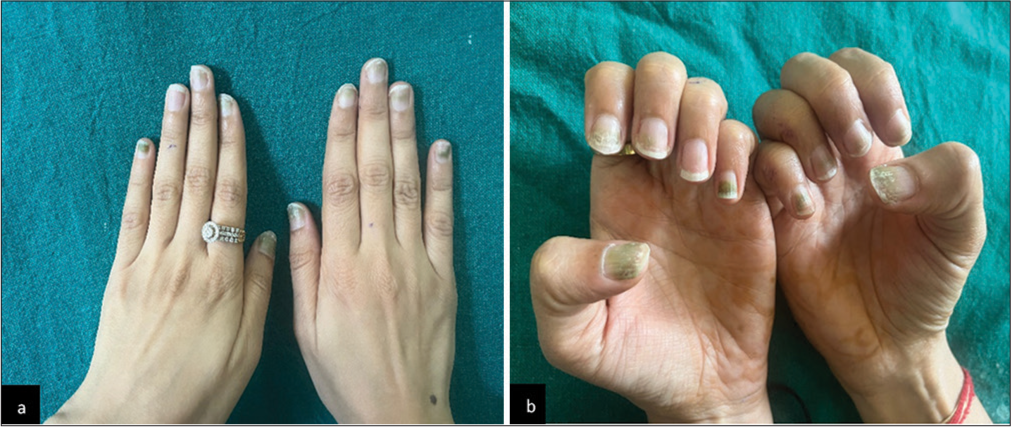
- (a and b) Clinical image showing greenish discoloration, roughening, and brittle nails after gel nail extension removal. (b: Close-up image).
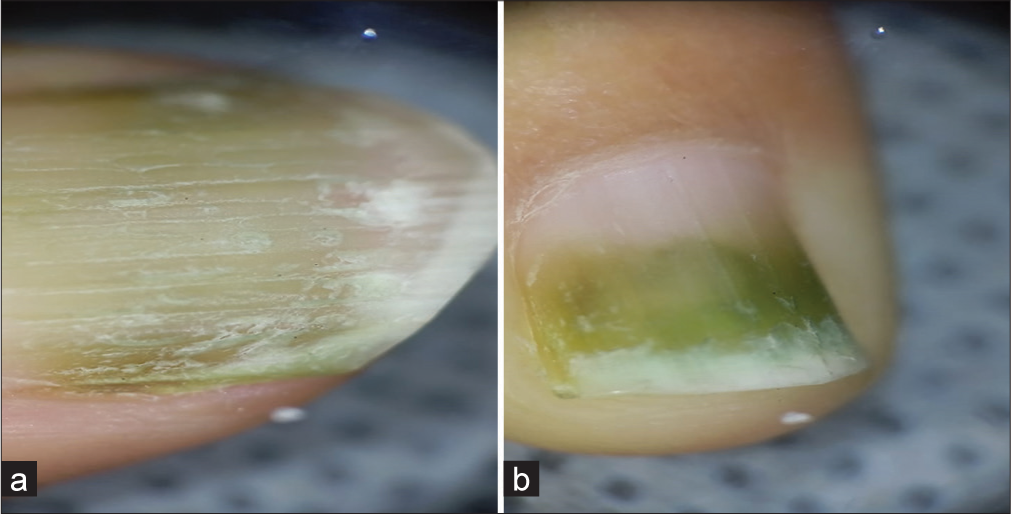
- (a and b) Dermoscopy of nails after gel nail extensions removal.
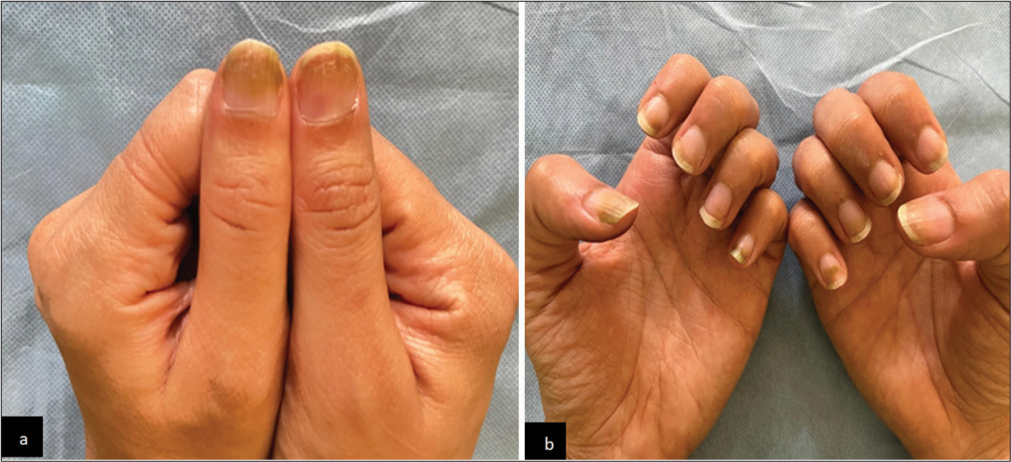
- (a and b) Clinical image showing decreased greenish discoloration, decreased roughening and brittle nails after 2 weeks of gel nail extension removal. (a: Bilateral thumbs, b: All fingers).
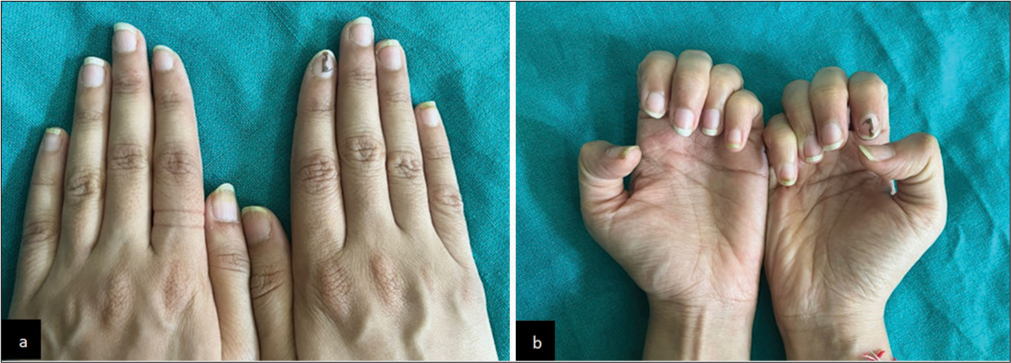
- (a and b) Clinical image showing significantly decreased greenish discoloration, decreased roughening and brittle nails after 6 weeks of gel nail extension removal. (b: Close-up image).
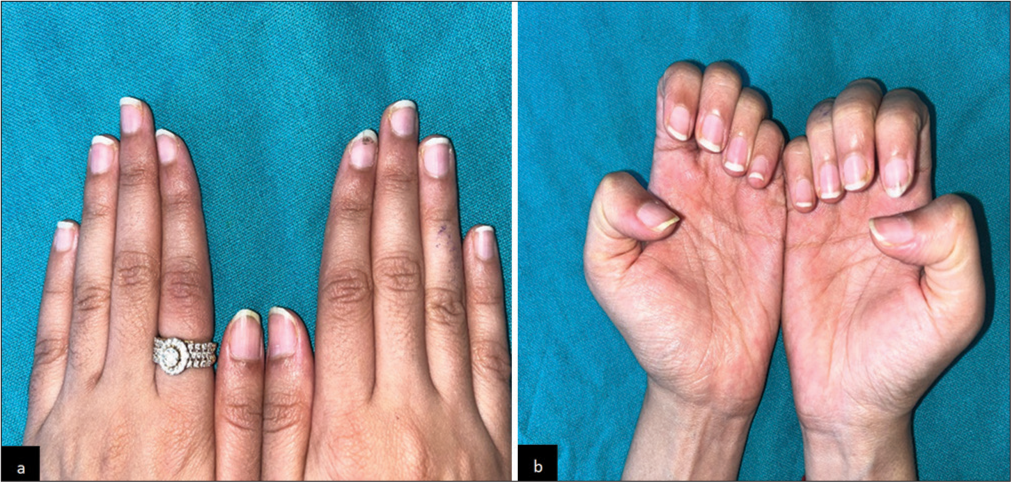
- (a and b) Clinical image showing resolution of greenish discoloration, and improvement in the nail plate surface roughening after 8 weeks of gel nail extension removal. (b: Close-up image).
DISCUSSION
Nail discoloration or dyschromia is an abnormality in the color of the nail plate. The pigments responsible for nail color alteration may be deposited either exogenously (occupational exposure, henna) or may be a result of overproduction of endogenously derived pigments[4] [Table 1]. A slight pressure over the nail plate blanches the discoloration due to altered vasculature of the nail bed, whereas if the abnormality is in the nail plate, the discoloration persists.[4] The various causes of nail dyschromia are summarized in Table 1. In our case, after the removal of gel nail extensions, there was greenish discoloration of the nails. The gel nail extensions require nail glue for fixation over the nail plate. Cyanoacrylate glues, used as adhesive agents to fix the nail tips to the nail plate surface, can lead to contact allergic dermatitis.[5-7] When cyanoacrylate comes into contact with moisture, such as the natural oil in nails or humidity in the air or prolonged contact with water, it can undergo a chemical reaction that produces a green pigment. Nail glue with higher concentrations of cyanoacrylate increases the risk of discoloration. Excessive exposure to moisture, such as prolonged contact with water or humid environments, can increase the likelihood of a reaction. Hence, applying a nail primer before using nail glue to create a moisture barrier helps in reducing the absorption and the pigmentation. Nail glues with a lower concentration of cyanoacrylate should be used to minimize the risk of discoloration. Other side effects noted with artificial nails include distal nail plate thinning due to chemical insult from acrylic nails and mechanical insult from nail filing.[8] A study was done that showed a flat, uniform appearance of a healthy nail as compared to fingernails exposed to synthetic nails and acrylic glue that was rough with globular areas.[9] Further, elemental analysis showed that nail glue causes degradation of disulfide bridges in the nail matrix, thereby destabilizing the matrix and causing roughness and loss of uniformity. The glue decreased the amount of silicon and aluminum in the nail, thereby decreasing the brightness and hardness of the nail.[9] In our case, apart from green discoloration, there was thinning, roughening, and increased fragility of fingernails. Other complications include paronychia, subungual swelling, severe pruritus, onycholysis, subungual hyperkeratosis, nail dystrophy, and scaling, vesicular dermatitis.[10] Artificial nails also serve as a nidus for nosocomial infections in healthcare facilities (carries more Gram-negative bacilli, Staphylococcus aureus, enterococci, and yeast).[11] A study done by Putek et al.[10] regarding the side effects associated with gel nail polish showed that 77.4% of respondents who reported side effects associated with gel nail polish wanted to continue the use of gel polish. It is likely that they regard the cosmetic benefits as more important than the risk of side effects. In our case, after the removal of gel nail extensions, there was greenish discoloration of the nails mimicking Pseudomonas infection. After proper history, examination and investigations, a provisional diagnosis of pigmentation from cyanoacrylate glue (which was used to fix the gel nail extensions over the nail plate) was kept. When cyanoacrylate comes into contact with moisture, such as the natural oil in nails or humidity in the air or prolonged contact with water, it can undergo a chemical reaction that produces a green pigment. Since the patient was stressed, proper counseling was done and the patient was given emollients and kept on regular follow-up. The discoloration improved and after 2 months, the nails resumed their normal color and texture. Hence, knowledge about these side effects is very necessary to avoid unnecessary medications. Since, nails nowadays are considered as a sign of beauty, and a status symbol, counseling and knowledge about nail cosmetics and their side effects and the importance of hygiene and good quality products are very important, as unhealthy nails severely impact the quality of life of patients.
| Types | Causes |
|---|---|
| White chromonychia – leukonychia | |
| True leukonychia | Mee’s lines, infections, drugs, dermatological diseases, systemic causes, dietary causes |
| Apparent leukonychia | Muehrcke’s nail, Terry’s nail, half and half nail (Lindsay nails) |
| Pseudoleukonychia | White discoloration of the nail due to onychomycosis or keratin deposits due to nail varnish |
| Black chromonychia – melanonychia | |
| Melanocytic hyperplasia | Lentigo Matrix melanocytic nevi Matrix melanoma |
| Melanocytic activation | Physiological, drugs, radiation, endocrine, nutritional, infections, trauma, inflammatory nail disorders and connective tissue diseases |
| Yellow chromonychia | Drugs like hydroxyurea (yellow-brown discoloration), tetracycline, penicillamine, antimalarials, gold Onychomycosis, psoriasis, and alopecia areata |
| Yellow-nail syndrome | Yellow nail, lymphedema and pleural effusion |
| Blue chromonychia | Drugs- Minocycline, antimalarials, chemotherapeutics like cyclophosphamide, doxorubicin, and bleomycin cocktail therapy Wilsons disease (causing Azure lunula), glomus tumor of nail, digital arteriovenous malformation, hereditary acrolabial telangiectasia, and advanced AIDS infection |
| Red chromonychia | |
| Red lunula | Psoriasis, alopecia areata, systemic lupus erythematosus, and trachyonychia Endocrine, gastrointestinal, cardiovascular, neurological, rheumatic, and infectious disorders |
| Longitudinal erythronychia | Dariers’s disease, lichen planus, amyloidosis, warty dyskeratoma, acrokeratosis verruciformis, glomus tumor, onychopapilloma of nail bed, Bowen’s disease, malignant melanoma |
| Green chromonychia | Bacterial infection (Pseudomonas aeruginosa), trauma, after nail procedures (gel nail extensions) |
| Dyschromia due to exogenous causes | |
| Yellow discoloration | Dinitrochlorobenzene, fluorescein, formaldehyde, nitric acid, resorcinol, tar, tartrazine |
| Brown discoloration | Potassium permanganate, henna, tobacco, iodine, hydroquinone, iron |
| Red discoloration | Eosin, mercurochrome |
| Blue discoloration | Methylene blue, cupric sulfate |
| Black discoloration | Silver nitrate |
| Purple discoloration | Gentian violet |
CONCLUSION
Nail cosmetics are considered to be relatively safe; however, they can lead to significant contact allergic or irritant dermatitis, infections, and nail damage. Cyanoacrylate glues, used as adhesive agents to fix the nail tips to the nail plate surface, can lead to contact allergic dermatitis. In our case, pigmentation from cyanoacrylate glue (which was used to fix the gel nail extensions over the nail plate) resulted in greenish discoloration of the nails. Therefore, education about the risk of side effects and sensitization is crucial to prevent infections and contact dermatitis and promote safe nail cosmetics in patients and manage complications.
Ethical approval
The Institutional Review Board approval is not required.
Declaration of patient consent
The authors certify that they have obtained all appropriate patient consent.
Conflicts of interest
There are no conflicts of interest.
Use of artificial intelligence (AI)-assisted technology for manuscript preparation
The authors confirm that there was no use of artificial intelligence (AI)-assisted technology for assisting in the writing or editing of the manuscript and no images were manipulated using AI.
Financial support and sponsorship
Nil.
References
- Nail beauty therapy: An attractive enhancement or potential hazard. J Cosmet Dermatol. 2002;1:24-9.
- [CrossRef] [Google Scholar]
- Screening for contact allergy to artificial nails. Contact Dermatitis. 2005;52:73-7.
- [CrossRef] [Google Scholar]
- Contact sensitization to cyanoacrylate adhesive as a cause of severe onychodystrophy. Int J Dermatol. 1998;37:31-6.
- [CrossRef] [Google Scholar]
- Sensitization to acrylates is a common adverse reaction to artificial fingernails. J Eur Acad Dermatol Venereol. 2007;21:169-74.
- [CrossRef] [Google Scholar]
- Adverse effects of nail cosmetics and how to prevent them. Cosmoderma. 2024;4:44.
- [CrossRef] [Google Scholar]
- Worn down nails after acrylic nail removal. Dermatol Online J. 2015;21:14.
- [CrossRef] [Google Scholar]
- Nail damage (severe onychodystrophy) induced by acrylate glue: Scanning electron microscopy and energy dispersive X-ray investigations. Skin Appendage Disord. 2017;2:137-42.
- [CrossRef] [Google Scholar]
- Side-effects associated with gel nail polish: A self-questionnaire study of 2,118 respondents. Acta Dermatol Venereol. 2020;100:adv00325.
- [CrossRef] [Google Scholar]
- Nail cosmetics: A dermatological perspective. Clin Exp Dermatol. 2019;44:599-605.
- [CrossRef] [Google Scholar]






